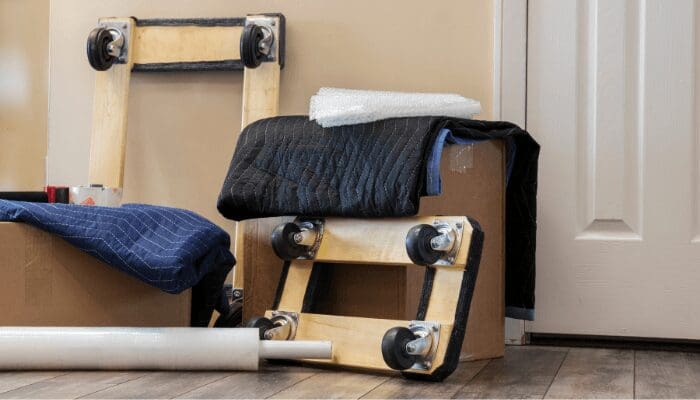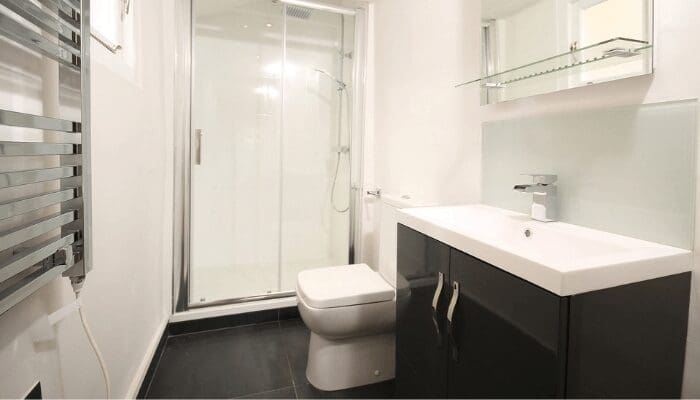Your Quick Moving To Do List: 10 Last-Minute Checks for Home Sellers
- Published on
- 6 min read
-
 Catherine Conelly Contributing AuthorClose
Catherine Conelly Contributing AuthorClose Catherine Conelly Contributing Author
Catherine Conelly Contributing AuthorCatherine has 8 years of experience as a writer and editor. Her work can be seen in PopSugar, Thrillist, Shape, and SheKnows. She holds a Bachelor's Degree in Creative Writing from Arizona State University and currently resides in Arizona.
As we scoured through traditional moving to-do lists, we noticed something. They are daunting, but not necessarily tailored.
Sometimes comprehensive is what you need. If so, head to our existing guides on how to pack like a perfectionist, calculate the exact number of boxes you need and find them on the cheap, and organize it all with an exhaustive moving checklist.
But home sellers face unique challenges in a move as they pass the baton off to the buyers. So we decided to research: What’s most likely to slip a seller’s mind as the deal comes to a close? And then we picked the brain of a top-rated real estate agent to get her take.
The result: Here’s a list of moving to-dos for sellers that are easy to forget about in the heat of the move.
These are the key tasks required to keep buyers happy and reduce the risk of the sale falling through:
- Lock all windows and doors before you leave.
- Do a final sweep in those out-of-sight, out-of-mind rooms (basement, attic, garage, storage rooms, refrigerator).
- Gather all garage keys, codes, and passwords the buyer will need to get in.
- Disconnect your smart home devices.
- Stock up on supplies that protect your floors and walls.
- Set a stop date for utilities, and restart them at your new property.
- Take pictures to prove the house was in good shape when you left.
- Set aside important docs you need for closing.
- Put together a box of cleaning supplies that stays accessible.
- Coordinate with the buyers about when you’ll be 100% out.
If you’re wondering what exactly some of these mean and how they make your life easier, let’s dive in.

1. Lock all windows and doors before you leave.
Most of the time, the buyers’ occupancy date will be the same as the close date—but not always.
For example, the buyers may be moving from out of state and need a few days after the transaction goes through as they haul their belongings across state lines.
The problem with that? Houses that look vacant are low-hanging fruit for burglars and squatters who are banking on you forgetting about that one window in that one room. In fact, 30% of burglaries result from unlocked doors and windows.
Or let’s say you begin moving out a few days before your close date, slowly settling into your new house. Your original home still has the for-sale sign and doesn’t appear to be lived in. A burglar strikes. Technically, the buyers have the right to back out of the sale, whether because the house suffered damage or they’re now questioning the safety of the area.
Burglars don’t care that the laptop and the 4K flat screen are moved out; they may want to get their hands on valuable building materials such as copper or appliances left behind as part of the sale.
Smart devices and expensive-looking fixtures can also look attractive to sticky fingers. Always do a final lockup to keep the chaos out.
2. Do a final sweep in those out-of-sight, out-of-mind rooms (basement, attic, garage, storage rooms, refrigerator).
Adopting the Marie Kondo’s lifestyle is great and all, but leaving your old junk behind for the next homeowners is not the way to do it. If your buyers walk in and discover items you didn’t take with you, like holiday decorations in the attic or old tools left in the garage, you’ll have to make it right. And it doesn’t matter if you’ve moved out of state.
“We’ll take care of the problem monetarily, and we’ll just take that out of that escrow money,” explains Dakota Riley, a top 1% real estate agent in Weymouth, Massachusetts. “So it will be remedied either by yourself physically or by that money that’s sitting [in escrow]. And then you will receive less of your home sale proceeds.”
Bottom line: Leave no item behind. That box of old books in the attic and the bag of winter clothes you keep on the tip-top shelf in the closet, take it all. Think about the rooms and areas of your home you didn’t often access— double and triple check them for items you may have forgotten you owned.

3. Gather all garage keys, codes, and passwords the buyer will need to get in.
Think about everything that’s either password and padlock protected, and make sure the buyer has the keys and remotes they’ll need. While it’s safe to assume the new homeowners will change the locks, you still have to provide all the copies of your key. Don’t forget these items and bring them to the final signing unless instructed otherwise by your agent:
- All copies of the door keys
- Gate keys
- Keys to outdoor, detached sheds or other locked storage closets
- Garage door remotes and passcodes
- Mailbox keys
- Pool keys, or keys needed for any other amenities such as a fitness center (common with condos and townhomes)
- Bonus: Leave behind all warranty information on major appliances if they’re still valid, as well as any owners manuals for items like the microwave and HVAC system.
4. Disconnect your smart home devices.
If you showed your home with Nest thermostats, smoke detectors, and security cameras installed and you didn’t exclude them in your agreement with the buyer, those items stay with the home. Don’t rip them out and take them with you.
Riley compares it to luxury fixtures and home appliances.
“If they make that offer and you had this fixture and that fixture, and then the buyer comes, and you’ve swapped everything out with the lowest line from Home Depot, that’s not gonna fly,” she explains.
And if these devices are staying with the home, make a mental note to disconnect them from your app. You don’t want to accidentally spy on the new homeowners or track their energy use. Even if it’s an accident, it may get awkward when they have to reach out and ask you to disconnect from said devices.

5. Stock up on supplies that protect your floors and walls.
Unlike moving out of a rental, there’s no cleaning deposit you’re trying to receive back. However, you’re still required to leave the house in good condition, and that means not causing extra damage.
“You need to convey the property in the condition it was when the buyer saw it,” says Riley. Don’t think the buyer won’t notice if you ding the corner of the hallway or leave holes in the walls that may have been covered during their walk-through.
A quick trip to your local hardware store for some extra moving supplies can help prevent damage (if you’re hiring movers, make sure they come prepared):
- Floor protection, $30 (taping down cardboard works, too)
- Moving straps, $20 (gives you more control over large items)
- Moving blankets to pad furniture, $10
- Dollies (prices vary)
If you damage any part of the wall, the buyer may have grounds to barter for some of their escrow money, cutting into your proceeds. Save the headache and patch them up. Use this tutorial to repair small holes. For larger ones, follow these steps to patch and repair drywall.
6. Set a stop date for utilities, and restart them at your new property.
You don’t want to be charged extra for usage on the days you weren’t occupying the house, but equally important is to make sure you have running water and electricity in your new home.
Call the utility companies to schedule a final read based on when the close is official. Some companies will simply be able to transfer the service to your new home, but if you’re moving out of state, you may have to set up a new service. Or in the case of water and trash, you’ll have to contact your new city.
Some homeowners whose homes still rely on heating oil may also accidentally leave money on the table.
“Generally around here [in the Northeast] you can get reimbursed for whatever oil you have left in the tank because you paid for it,” says Riley. But in the hustle of the move, you may not be thinking about that. “[Then] you get to the closing, and there’s nothing in writing that says that buyer owes you anything.”

7. Take pictures to prove the house was in good shape when you left.
Renters are often advised to take pictures of their unit when they move out so their landlord can’t unfairly pin damage on them and hold their security deposit. But it’s also a good practice for homeowners when they hand over the keys, especially in the case that the new owners won’t be moving in right away.
You never know what might happen from the time you move out to the time the new owners move in, from burglaries to their movers causing damage and claiming it was already there. That’s assuming the worst, but in 2018, the Better Business Bureau received over 9,000 complaints about bad movers, many of which included damage.
8. Set aside important docs you need for closing.
Here’s a checklist of what you’ll need when you close the sale on your home. Make sure it doesn’t get packed:
- A copy of the purchase contract. The escrow agent and your real estate agent will most likely have this, but it doesn’t hurt to have a backup.
- Driver’s license
- All keys, remotes, and passcodes (see list above)
- Information about how to access smart devices if the home has them
- Any funds you’ve agreed to pay the buyer
- Your checkbook because you never know what small costs may arise toward the end of closing
9. Put together a box of cleaning supplies that stays accessible.
Keep a set of cleaning supplies easily accessible. You’ll want them handy to make sure the home is broom swept so you don’t have to hear complaints from the buyer after moving day (not that they’re not perfectly lovely people). These items will also come in handy as you’re moving into your new home.
You may want some additional items that aren’t on this list like hand soap, disposable eatery, and a tool kit, but these are most important for making sure the house is broom swept and the buyer is happy when they walk in for the first time.
- Antibacterial wipes or other surface disinfectants
- Swiffer dusters
- Rags and sponges
- Bucket
- Vacuum
- Wood cleaners
- Toilet cleaner
- Gloves
- Glass cleaner
- Trash bags
- Magic Eraser
- Oven cleaner
- Floor cleaner
- A traditional mop and bucket, Swiffer Wet Jet, or Bona mop

10. Coordinate with the buyers about when you’ll be 100% out.
In all the moving chaos, don’t forget to communicate with your agent on when exactly you need to be out of the home. Your house changes possession when the funding goes through, unless otherwise stipulated in the contract.
You don’t want to be caught with boxes in your hand at the final hour. Read: They show up with a moving truck and you still have boxes stacked in your their garage. It seems like an obvious step, but moving miscommunication happens. To avoid it, check the contract, talk to your agent, and confirm (then re-confirm) when the buyers plan to show up so you can be totally out.
Header Image Source: (Kim Wooters/ Death to the Stock Photo)
